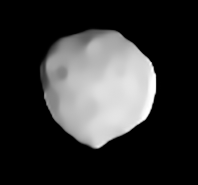 VLT image of Bamberga | |
| Discovery | |
|---|---|
| Discovered by | Johann Palisa |
| Discovery date | 25 February 1892 |
| Designations | |
| (324) Bamberga | |
| Pronunciation | /bæmˈbɜːrɡə/ |
Named after | Bamberg |
| Main belt | |
| Adjectives | Bambergian /bæmˈbɜːrdʒiən, -ɡiən/ |
| Orbital characteristics[1] | |
| Epoch 31 July 2016 (JD 2457600.5) | |
| Uncertainty parameter 0 | |
| Observation arc | 124.08 yr (45321 d) |
| Aphelion | 3.59442 AU (537.718 Gm) |
| Perihelion | 1.77023 AU (264.823 Gm) |
| 2.68232 AU (401.269 Gm) | |
| Eccentricity | 0.34004 |
| 4.39 yr (1604.6 d) | |
| 225.419° | |
| 0° 13m 27.682s / day | |
| Inclination | 11.1011° |
| 327.883° | |
| 44.2409° | |
| Physical characteristics | |
| Dimensions | c/a = 0.96±0.05[2] |
| 227±3 km[2] 234.67 ± 7.80 km[3] 229.4 ± 7.4 km (IRAS)[4] | |
| Mass | (10.2±0.9)×1018 kg[2] 11×1018 kg[5] (10.3±1.0)×1018 kg[3] |
Mean density | 1.67±0.16 g/cm3[2] 1.52±0.20 g/cm3[3] |
| 1.226 d[6] 29.43 h (1.226 d)[1] | |
| 0.060 (calculated)[2] 0.0628±0.004[4] | |
| C-type asteroid[7] | |
| 6.82[1][4] | |
324 Bamberga is one of the largest asteroids in the asteroid belt. It was discovered by Johann Palisa on 25 February 1892 in Vienna. It is one of the top-20 largest asteroids in the asteroid belt. Apart from the near-Earth asteroid Eros, it was the last asteroid which is ever easily visible with binoculars to be discovered.
Overall Bamberga is the tenth-brightest main-belt asteroid after, in order, Vesta, Pallas, Ceres, Iris, Hebe, Juno, Melpomene, Eunomia and Flora. Its high eccentricity (for comparison 36% higher than that of Pluto), though, means that at most oppositions other asteroids reach higher magnitudes.
- ^ a b c "JPL Small-Body Database Browser: 324 Bamberga". 2008-07-26 last obs. Retrieved 11 May 2016.
- ^ a b c d e P. Vernazza et al. (2021) VLT/SPHERE imaging survey of the largest main-belt asteroids: Final results and synthesis. Astronomy & Astrophysics 54, A56
- ^ a b c Cite error: The named reference
Carry2012was invoked but never defined (see the help page). - ^ a b c Tedesco, E.F.; Noah, P.V.; Noah, M.; Price, S.D. (2004). "IRAS Minor Planet Survey. IRAS-A-FPA-3-RDR-IMPS-V6.0". NASA Planetary Data System. Archived from the original on 19 January 2007. Retrieved 15 March 2007.
- ^ Pitjeva, E. V. (2005). "High-Precision Ephemerides of Planets—EPM and Determination of Some Astronomical Constants" (PDF). Solar System Research. 39 (3): 176. Bibcode:2005SoSyR..39..176P. doi:10.1007/s11208-005-0033-2. Archived from the original (PDF) on 31 October 2008.
- ^ Harris, A. W.; Warner, B.D.; Pravec, P., eds. (2006). "Asteroid Lightcurve Derived Data. EAR-A-5-DDR-DERIVED-LIGHTCURVE-V8.0". NASA Planetary Data System. Archived from the original on 28 January 2007. Retrieved 15 March 2007.
- ^ Neese, C., ed. (2005). "Asteroid Taxonomy.EAR-A-5-DDR-TAXONOMY-V5.0". NASA Planetary Data System. Archived from the original on 10 March 2007. Retrieved 15 March 2007.